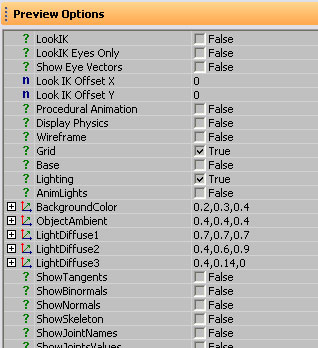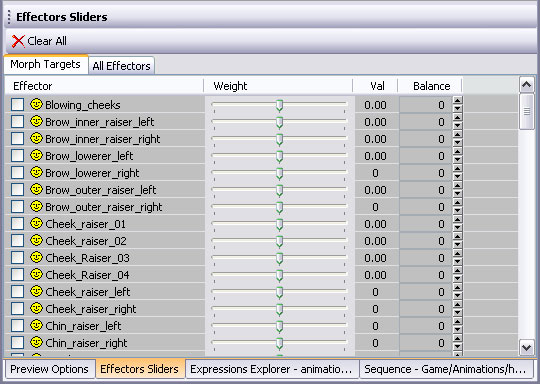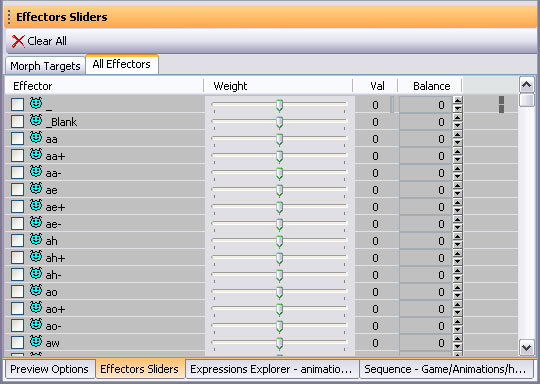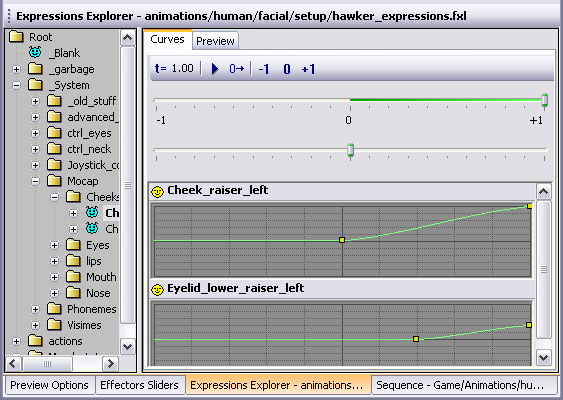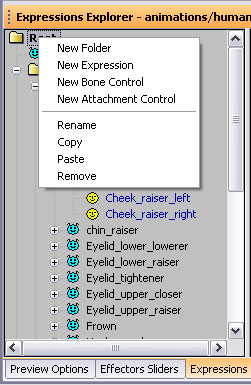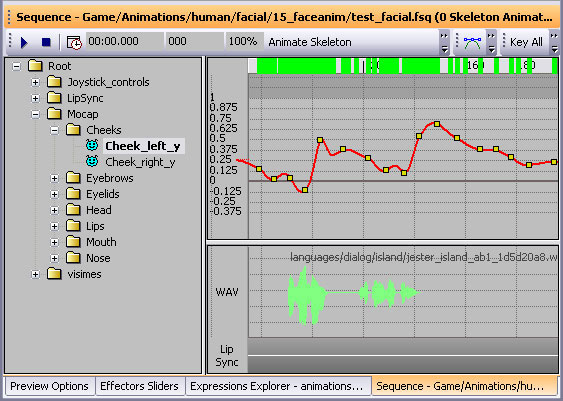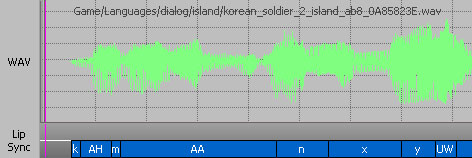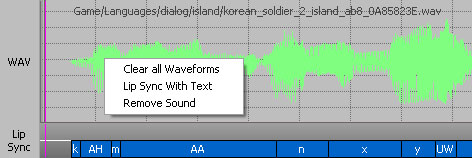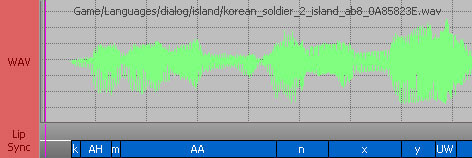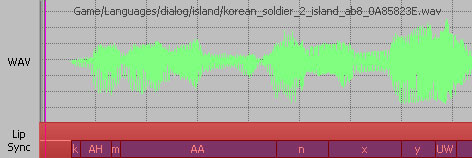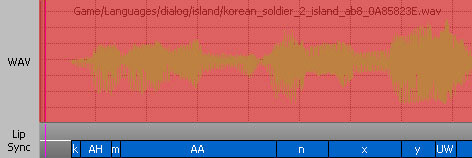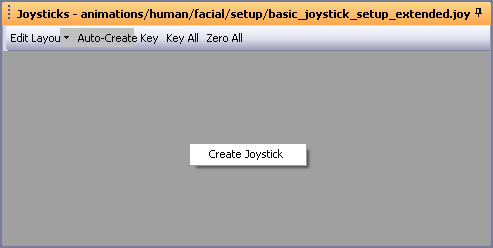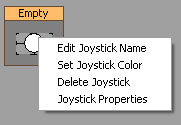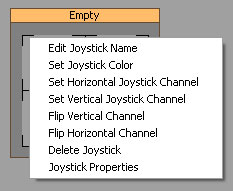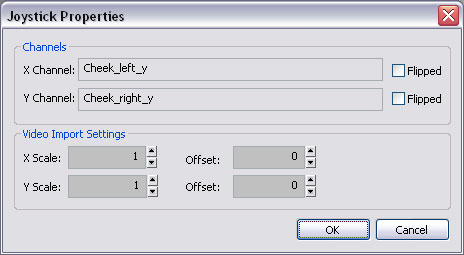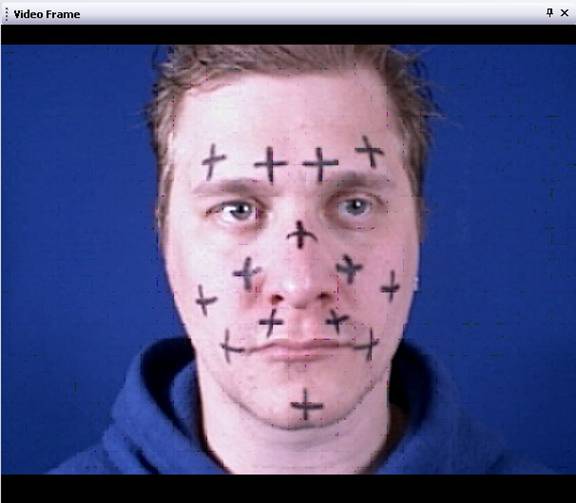Меню и параметры Facial Editor
Материал из CryWiki Russia
Статью пометил сам автор статьи.
Содержание |
Меню и параметры Facial Editor
Overview
The following sections document the Facial Editor, its functions and views.
Menus
The following section describes each pull down menu option and its function within the facial editor.
Project
- New — Create new project.
- Open — Open project.
- Save — Save project.
- Save As — Save project and specify name/location.
Edit
- Undo — Undo last operation.
- Redo — Redo operation after undo.
Expressions Library
- New — Create new expression library.
- Open — Open expression library
- Save — Save expression library.
- Save As — Save expression library and specify name/location.
- Export Selected Expressions — Create a new expression library containing only the selected expressions.
- Import Expressions — Open an existing expression library and merge the expressions into the current one.
- Batch Update With Selected Expressions — Select a series of expression library files and merge the expressions that are currently selected into them, replacing the expressions in each library if they already exist.
- Morph Check — Display a list of all morphs that are referenced in the expression library that are missing in the currently loaded character.
Character
- Load — Load a CHR character.
Sequence
- New — Create new sequence.
- Open — Open sequence
- Save — Save sequence.
- Save As — Save sequence and specify name/location.
- Load Sound — Load a compatible .wav file into the sequence.
- Load Skeleton Animation — Load a skeletal animation for the character. Only animations available through the cal (Crytek Animation List) file are accessible.
- Batch Apply Expression — Unsupported.
- Export Selected Expressions — Create a new sequence file containing only the currently selected channels.
- Import Expressions — Read the channels from an existing sequence file and merge them into the current sequence.
- Batch Update With Selected Expressions — Open a series of sequences and merge the channels that are currently selected in the sequence dialog into each one, replacing the channels if they already exist.
- Load Video Extracted Sequence — Load a text file generated by the FaceAnim utility, used for motion capture of an actors face. Both curves and video are imported.
- Load Video (Ignore Sequence) — Load a text file generated by the FaceAnim utility used for motion capture of an actors face, but ignore the motion data and loads the video only.
- Load Group File — Load a .grp file which was saved from the level editor. GRP files are exported sequence objects which appear in the level when a new trackview sequence is created. Saving these objects as grp files exports an XML format of everything contained in the sequence from audio positions, to skeletal animation and camera paths. This can then be imported into a facial sequence for use in the Facial Editor.
Joysticks
- New — Create new joystick file.
- Open — Open joystick file.
- Save — Save joystick file.
- Save As — Save joystick file and specify name/location.
- Create Expression From Current Positions — Take the expression currently being shown on the character, as defined by the joysticks, and create an entry in the expression library that captures it.
Lip Sync
- Extract Phonemes — Analyze the currently loaded waveforms and select a series of phonemes to use for lip sync. If known, the text that the sound represents can be entered — this is used to improve the accuracy of the result.
- Batch Process Directory — Batch processes a directory of audio, into fsq files using the same name as the audio file itself.
Views
Preview Options
Preview Options contain a list of functions from debug display modes to general display options.
Effectors Sliders
- Clear All — Unsupported.
- Morph Targets Tab — Lists all available morph targets in the character. Weight sliders within this view allow the user to preview each morph by moving the slider to the left (negative values), or to the right (positive values). Balance allows asymmetrical preview of each shape or morph.
- Effector — Displays the name of the morph targets stored within the character. The checkbox next to the name of the morph enables and disables the effect of the weight slider.
- Weight — Slider to move the morph target from neutral position to negative or positive values.
- Val — Displays the position value of the slider in numerical form.
- Balance — Control the balance factor or symmetry or the morph.
- Effector — Displays the name of the morph targets stored within the character. The checkbox next to the name of the morph enables and disables the effect of the weight slider.
- All Effectors Tab — Similar to the previous tab, but lists all possible effectors from morphs to expressions.
- Effector — Displays the name of the effectors available from morph targets to composed expressions. The checkbox next to the name of the effector enables and disables the effect of the weight slider.
- Weight — Slider to move the effector from neutral position to negative or positive values.
- Val — Displays the position value of the slider in numerical form.
- Balance — Control the balance factor or symmetry or the effector.
- Effector — Displays the name of the effectors available from morph targets to composed expressions. The checkbox next to the name of the effector enables and disables the effect of the weight slider.
Expressions Explorer
Expressions Tree View* – Lists expressions that have been assembled into an expression library. Within this view the user can define the existing morphs in the character and compose them into expressions using a right click menu interface (below).
Expressions Tree View – Right Click Menu
New Folder – Create a new folder.
New Expression – Add existing morph or create a new expression.
New Bone Control – Create a new bone controller or channel through which bones within the character can be animated.
New Attachment Control – Create an expression that rotates an attachment (not supported for skin attachments).
Rename – Rename an expression or folder.
Copy – Copy an expression.
Paste – Paste an expression.
Remove – Remove expression or folder.
Curves Tab* – Curves tab allows the user to control how multiple shapes will blend when the expression transitions from minimum amplitude to full amplitude.
![]() Time value from −1.0 to 1.0.
Time value from −1.0 to 1.0.
![]() Plays the morph/expression sequence.
Plays the morph/expression sequence.
![]() Toggles play button to start at −1.0 (off) or from 0 only (on).
Toggles play button to start at −1.0 (off) or from 0 only (on).
![]() Set slider position to 0.
Set slider position to 0.
![]() Set slider position to −1.
Set slider position to −1.
![]() Set slider position to +1.
Set slider position to +1.
![]() Top slider sets expression from −1.0 to 1.0.
Top slider sets expression from −1.0 to 1.0.
![]() Lower slider sets balance from −1.0 to 1.0.
Lower slider sets balance from −1.0 to 1.0.

Spline Display. Defines how morph shapes blend in over the time an expression (multiple morphs) transition from minimum amplitude to full amplitude.
Preview Tab* – Unsupported.
Sequence View
Sequence view displays all related information about the sequence from expressions, to audio and the curves/keyframes themselves.
Sequence Tree View* – Allows the creation of a list of available expressions which can be directly animated within the sequence. These are assembled by adding shapes and expressions from the expression library into the tree view.
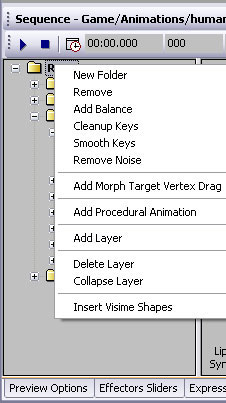
Sequence View – Right Click Menu
New Folder – Create a new folder.
Remove – Remove element such as a folder or an expression.
Add Balance – Add balance track that controls asymmetry.
Cleanup Keys – Reduce keys based on threshold set by user.
Smooth Keys – Function to smooth over noise. Mostly used for mocap data.
Remove Noise – Function to remove noise. Mostly used for mocap data.
Add Morph Target Vertex Drag – Unsupported.
Add Procedural Animation – Unsupported.
Add Layer – Add layer useful for modifying large amounts of sequential keys.
Delete Layer – Delete layer.
Collapse Layer – Commit changes made within a layer to base curves permanently.
Insert Viseme Shapes – Mode in which morphs can be entered in text form to produce overlapping shapes which blend in and out of one another. This is useful for producing fast layouts of visemes for keyframed lip sync. Expressions must have “visim” as a prefix in the name.
Curve Track
Curve Track – Key Bar (highlighted in red below) The key bar displays any keys within the selected track which can be manipulated in the same way as in the main curve view, though locked to the horizontal axis. This is useful for scaling time of a group of keys without accidentally altering amplitude.
Curve Track – Amplitude (highlighted in red below) Amplitude displays the entire range accessible for a particular expression or joystick control. Though depending on actual setup ranges below zero may not necessarily have any effect.
Curve Track – Curve Display (highlighted in red below) The curve display shows both the curve of the selected track as well as the keys themselves.
Audio Track*
Audio Track – Right Click Menu
Clear all Waveforms – Removes all wav forms from the track. Lip Sync With Text – Opens dialogue where text can be entered which matches the spoken audio and will generate an appropriate list of phonemes. If left empty the plugin does it’s best to guess the phonemes necessary. Remove Sound – Removes wav file from sound track.
Audio Track – Label Bar (highlighted in red below) Labels the wav and lip sync portions of the audio track.
Audio Track – Lip Sync Bar (highlighted in red below) The lip sync bar displays the morphs which have been added through a referenced recording list, or through the “lip sync with text” option. The bar is split into 2 sections. The upper section stores the words that may have been entered to guide the lip sync extraction process and the lower half shows the phonemes that have been used to create the extracted lip sync.
Audio Track – Wav Display (highlighted in red below) Displays wav files added to the sequence in graphical form as well as the file name and it’s location on disk.
Sequence View Toolbars*
![]() Play Sequence – Plays the sequence
Play Sequence – Plays the sequence
![]() Stop Sequence – Stops playback of the sequence
Stop Sequence – Stops playback of the sequence
![]() Facial Sequence Properties – Displays start and end times of the sequence or enables
Facial Sequence Properties – Displays start and end times of the sequence or enables
![]() Current Sequence Time – shows current sequence time.
Current Sequence Time – shows current sequence time.
![]() Current Frame No – Shows frame number at current time.
Current Frame No – Shows frame number at current time.
![]() Playback Speed – Shows current playback speed in percent.
Playback Speed – Shows current playback speed in percent.
![]() Animate Skeleton – Plays back selected animation on the character.
Animate Skeleton – Plays back selected animation on the character.
![]() Sequence Camera – Plays back camera animation loaded from a “sequence object” saved from a cinematic in trackview.
Sequence Camera – Plays back camera animation loaded from a “sequence object” saved from a cinematic in trackview.
![]() Overlap Sounds – Allows sounds to overlap when they have been placed in an overlapping fashion. When it is off, sounds are trimmed when a new sound begins to play.
Overlap Sounds – Allows sounds to overlap when they have been placed in an overlapping fashion. When it is off, sounds are trimmed when a new sound begins to play.
![]() Key All – Creates key for every track selected in tree view.
Key All – Creates key for every track selected in tree view.
![]() Zero All – Sets keys for selected tracks in tree view to 0 amplitude.
Zero All – Sets keys for selected tracks in tree view to 0 amplitude.
![]() Amplitude – Adjusts amplitude of curve for a selected range.
Amplitude – Adjusts amplitude of curve for a selected range.
![]() Smooth – Smooths noise of selected keys. Useful for mocap.
Smooth – Smooths noise of selected keys. Useful for mocap.
![]() Smooth Value – Sets the value used for the smoothing operation.
Smooth Value – Sets the value used for the smoothing operation.
![]() Cleanup Keys – Removes keys based on user defined threshold.
Cleanup Keys – Removes keys based on user defined threshold.
![]() Cleanup Keys Value – Sets value for cleanup operation.
Cleanup Keys Value – Sets value for cleanup operation.
![]() Remove Noise – Attempts to remove noise based on user defined threshold.
Remove Noise – Attempts to remove noise based on user defined threshold.
![]() Remove Noise Value – Sets value for remove noise operation.
Remove Noise Value – Sets value for remove noise operation.
![]() Reset all tangent settings.
Reset all tangent settings.
![]() Set the incoming tangent to 0.
Set the incoming tangent to 0.
![]() The spline evaluates to a constant value until it gets to this key.
The spline evaluates to a constant value until it gets to this key.
![]() Allow the spline not to be smooth as it reaches this key.
Allow the spline not to be smooth as it reaches this key.
![]() Set the outgoing tangent to 0.
Set the outgoing tangent to 0.
![]() The spline evaluates to a constant value after this key.
The spline evaluates to a constant value after this key.
![]() Allow the spline not to be smooth as it leaves this key.
Allow the spline not to be smooth as it leaves this key.
![]() Zoom Extents horizontal
Zoom Extents horizontal
![]() Zoom Extents vertical
Zoom Extents vertical
![]() Grid snap horizontal
Grid snap horizontal
![]() Grid snap vertical
Grid snap vertical
Joysticks View
Joysticks are user defined 2d controllers with a single manipulator that can be assigned to multiple morphs, expressions or other shapes in order to animate them in a graphical way – much like moving a physical joystick.
The Joystick view is where the user can start assembling joysticks and wire them up to morphs, expressions or visemes that have been made available in the sequence view.
![]() Toggle edit mode to resize or move joysticks in the view.
Toggle edit mode to resize or move joysticks in the view.
![]() Toggle create key mode, when a controller is moved a key is automatically created.
Toggle create key mode, when a controller is moved a key is automatically created.
![]() Key all joystick tracks.
Key all joystick tracks.
![]() Zero amplitude of all joysticks.
Zero amplitude of all joysticks.
Joystick Right Click Menu
Create Joystick – Creates a basic joystick without any active connections.
Joystick Right Click (no expression selected in tree view)
- Edit Joystick Name* – Renames joystick.
Set Joystick Color – Alters color of joystick.
Delete Joystick – Removes the joystick permanently.
Joystick Properties – Views properties page of joystick.
Joystick Right Click (expression selected in tree view)
Edit Joystick Name – Renames joystick.
Set Joystick Color – Alters color of joystick.
Set Horizontal Joystick Channel – Assigns selected expression in tree view to the horizontal channel of joystick control.
Set Vertical Joystick Channel – Assigns selected expression in tree view to the vertical channel of joystick control.
Flip Vertical Channel – Inverts the control of the Vertical axis.
Flip Horizontal Channel – Reverses the control of the horizontal axis.
Delete Joystick – Removes the joystick permanently.
Joystick Properties – Views properties page of joystick.
Joystick Properties
Channels Group
X Channel – displays the expression assigned to the X channel.
Y Channel – displays the expression assigned to the Y channel.
Flipped Checkbox – Inverts the X or Y channel.
Video Import Group
X Scale – Scales X component upon import.
Y Scale – Scales Y component upon import.
Offset – Offsets X or Y component upon import.
Video Frame
The video frame displays video loaded through the sequence menu in 2 ways. Either individual videos can be loaded using the “Load Video (Ignore Sequence)” option, or by explicitly loading both captured data (from the Faceanim tool) and video using the “Load Video Extracted Sequence” option.
